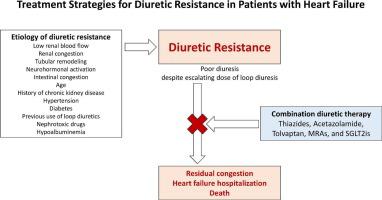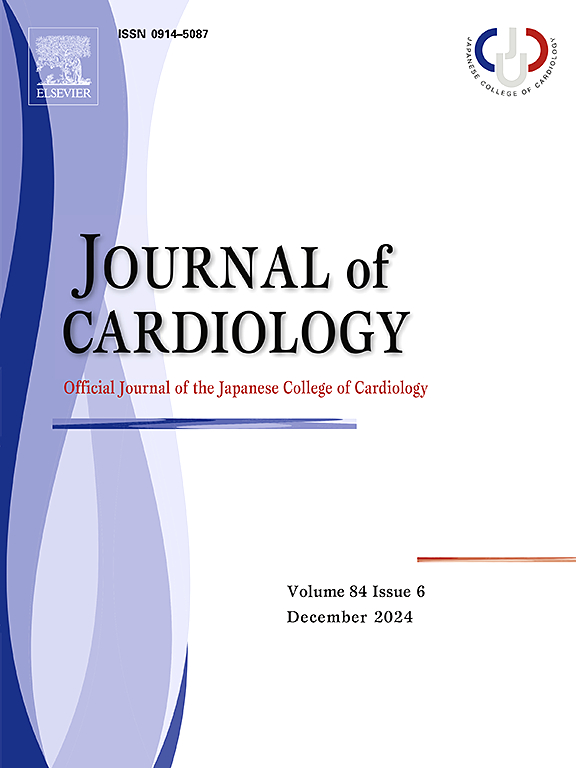心力衰竭患者利尿剂耐药性的治疗策略。
IF 2.5
3区 医学
Q2 CARDIAC & CARDIOVASCULAR SYSTEMS
引用次数: 0
摘要
在治疗心力衰竭(HF)的过程中,通过利尿剂治疗改善充血状况至关重要。然而,尽管使用了襻利尿剂,但利尿作用可能不足,充血仍然存在,这就是所谓的利尿剂抵抗。利尿剂抵抗和残余充血与较高的再住院风险和死亡率有关。导致心房颤动患者出现利尿剂抵抗的原因包括利尿剂药代动力学变化、肾血流动力学紊乱、神经体液激活、肾小管重塑、肾毒性药物的使用以及患者的合并症。联合利尿疗法(CDT)一直被提倡用于治疗利尿剂耐药性。噻嗪类药物、乙酰唑胺类药物、托伐普坦、矿皮质激素受体拮抗剂和钠-葡萄糖共转运体-2抑制剂等都是候选药物,但这些疗法均未显示出显著的利尿疗效或改善预后。目前,最重要的是找出并治疗个别患者的利尿剂耐药原因,并在更好地了解每种药物特性的基础上使用 CDT,以达到充分利尿的目的。要有效评估和管理利尿剂耐药性并最终改善患者预后,还需要进一步的研究。本文章由计算机程序翻译,如有差异,请以英文原文为准。


Treatment strategies for diuretic resistance in patients with heart failure
Improving congestion with diuretic therapy is crucial in the treatment of heart failure (HF). However, despite the use of loop diuretics, diuresis may be inadequate and congestion persists, which is known as diuretic resistance. Diuretic resistance and residual congestion are associated with a higher risk of rehospitalization and mortality. Causes of diuretic resistance in HF include diuretic pharmacokinetic changes, renal hemodynamic perturbations, neurohumoral activations, renal tubular remodeling, and use of nephrotoxic drugs as well as patient comorbidities. Combination diuretic therapy (CDT) has been advocated for the treatment of diuretic resistance. Thiazides, acetazolamides, tolvaptan, mineralocorticoid receptor antagonist, and sodium-glucose co-transporter-2 inhibitors are among the candidates, but none of these treatments has yet demonstrated significant diuretic efficacy or improved prognosis. At present, it is essential to identify and treat the causes of diuretic resistance in individual patients and to use CDT based on a better understanding of the characteristics of each drug to achieve adequate diuresis. Further research is needed to effectively assess and manage diuretic resistance and ultimately improve patient outcomes.
求助全文
通过发布文献求助,成功后即可免费获取论文全文。
去求助
来源期刊

Journal of cardiology
CARDIAC & CARDIOVASCULAR SYSTEMS-
CiteScore
4.90
自引率
8.00%
发文量
202
审稿时长
29 days
期刊介绍:
The official journal of the Japanese College of Cardiology is an international, English language, peer-reviewed journal publishing the latest findings in cardiovascular medicine. Journal of Cardiology (JC) aims to publish the highest-quality material covering original basic and clinical research on all aspects of cardiovascular disease. Topics covered include ischemic heart disease, cardiomyopathy, valvular heart disease, vascular disease, hypertension, arrhythmia, congenital heart disease, pharmacological and non-pharmacological treatment, new diagnostic techniques, and cardiovascular imaging. JC also publishes a selection of review articles, clinical trials, short communications, and important messages and letters to the editor.
 求助内容:
求助内容: 应助结果提醒方式:
应助结果提醒方式:


